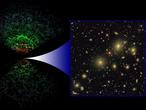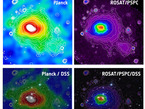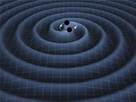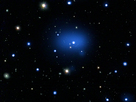Galaxy Clusters
A new supercluster, seen by Planck and XMM-Newton
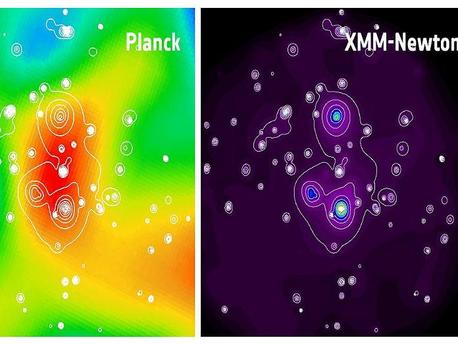 © Planck image: ESA/LFI & HFI Consortia; XMM-Newton image: ESA
|
This image shows the newly discovered supercluster of galaxies detected by Planck (with the Sunyaev-Zel'dovich Effect) and XMM-Newton (in X-ray emission). This is the first supercluster to be discovered through its Sunyaev-Zel'dovich Effect. Combined with other observations, the Sunyaev-Zel'dovich Effect allows astronomers to measure the physical properties of the hot gas (such as temperature and density) in which the galaxies are embedded. The bright orange blob in the left panel shows the Sunyaev-Zel'dovich image of the supercluster, obtained by Planck. After Planck's detection, follow-up observations were performed with the XMM-Newton observatory in the framework of a Planck source validation programme undertaken in Director's Discretionary Time. The right panel shows the X-ray image of the supercluster obtained with XMM-Newton, which reveals the three galaxy clusters that comprise this supercluster. The X-ray contours are also superimposed on the Planck image, as a visual aid. The Sunyaev-Zel'dovich signal from the newly discovered supercluster arises from the sum of the signal from the three individual clusters, with a possible additional contribution from an inter-cluster filamentary structure. The angular separation between the upper cluster and the one in the bottom-right is about 7.5 arc minutes. The small, round contours scattered throughout the field are not related to the supercluster; they are point-like X-ray sources located either in the background or foreground of the supercluster, and are most likely Active Galactic Nuclei. The X-ray emission shown in the XMM-Newton image corresponds to the energy range between 300 eV and 2000 eV, a temperature range of 3.5 million K to 23 million K, respectively. The size of the image is about 15 arc minutes.
"The synergy between the two missions has proved extremely successful, and XMM-Newton will continue following up Planck detections in order to confirm the nature of the cluster candidates," says Norbert Schartel, XMM-Newton Project Scientist. In the future, XMM-Newton may conduct further, deeper observations of some of these clusters in order to measure their properties in greater detail.
"This is the first time that a supercluster has been discovered via the SZE," adds Aghanim. "This important discovery opens a brand new window on superclusters, one which complements the observations of the individual galaxies therein."
The SZ signal from the newly discovered supercluster arises from the sum of the signal from the three individual clusters, with a possible additional contribution from an inter-cluster filamentary structure. This provides important clues about the distribution of gas on very large scales which is, in turn, crucial also for tracing the underlying distribution of dark matter.
"These first detections, revealing both previously known clusters and brand new ones, show that Planck is working extremely well," comments Tauber. "Of course, this is only a preview of the numerous discoveries that will surely come along during the lifetime of the mission."
Source: ESA
Galaxy Clusters
A new supercluster, seen by Planck and XMM-Newton
 © Planck image: ESA/LFI & HFI Consortia; XMM-Newton image: ESA
|
This image shows the newly discovered supercluster of galaxies detected by Planck (with the Sunyaev-Zel'dovich Effect) and XMM-Newton (in X-ray emission). This is the first supercluster to be discovered through its Sunyaev-Zel'dovich Effect. Combined with other observations, the Sunyaev-Zel'dovich Effect allows astronomers to measure the physical properties of the hot gas (such as temperature and density) in which the galaxies are embedded. The bright orange blob in the left panel shows the Sunyaev-Zel'dovich image of the supercluster, obtained by Planck. After Planck's detection, follow-up observations were performed with the XMM-Newton observatory in the framework of a Planck source validation programme undertaken in Director's Discretionary Time. The right panel shows the X-ray image of the supercluster obtained with XMM-Newton, which reveals the three galaxy clusters that comprise this supercluster. The X-ray contours are also superimposed on the Planck image, as a visual aid. The Sunyaev-Zel'dovich signal from the newly discovered supercluster arises from the sum of the signal from the three individual clusters, with a possible additional contribution from an inter-cluster filamentary structure. The angular separation between the upper cluster and the one in the bottom-right is about 7.5 arc minutes. The small, round contours scattered throughout the field are not related to the supercluster; they are point-like X-ray sources located either in the background or foreground of the supercluster, and are most likely Active Galactic Nuclei. The X-ray emission shown in the XMM-Newton image corresponds to the energy range between 300 eV and 2000 eV, a temperature range of 3.5 million K to 23 million K, respectively. The size of the image is about 15 arc minutes.
"The synergy between the two missions has proved extremely successful, and XMM-Newton will continue following up Planck detections in order to confirm the nature of the cluster candidates," says Norbert Schartel, XMM-Newton Project Scientist. In the future, XMM-Newton may conduct further, deeper observations of some of these clusters in order to measure their properties in greater detail.
"This is the first time that a supercluster has been discovered via the SZE," adds Aghanim. "This important discovery opens a brand new window on superclusters, one which complements the observations of the individual galaxies therein."
The SZ signal from the newly discovered supercluster arises from the sum of the signal from the three individual clusters, with a possible additional contribution from an inter-cluster filamentary structure. This provides important clues about the distribution of gas on very large scales which is, in turn, crucial also for tracing the underlying distribution of dark matter.
"These first detections, revealing both previously known clusters and brand new ones, show that Planck is working extremely well," comments Tauber. "Of course, this is only a preview of the numerous discoveries that will surely come along during the lifetime of the mission."
Source: ESA


